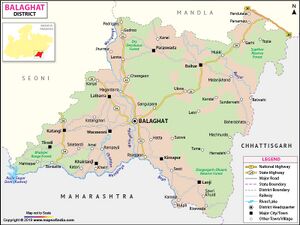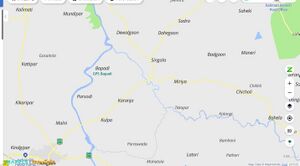Lanji
| Author:Laxman Burdak, IFS (R) |


Lanji (लांजी) is a town and tehsil of Balaghat district in Madhya Pradesh, India. Lanji was earlier known as Lanjika. It is mentioned in Koni Stone Inscription Of Prithvideva II - (Kalachuri) Year 900 (=1148 AD)[1] and No. 4 Kuruspal Stone Inscription of Somesvaradeva[2].
Location
Lanji is located close to the Madhya Pradesh's border with Chhattisgarh and Maharashtra. It is located approximately 62 km from the district headquarters Balaghat. It is home to the Koteshwar Shiva temple, Gangli-raja (a site of the Gondwana Kingdom), and the Lanji Fort.
Variants
Villages in Lanji Tahsil
Town: 1. Lanji
Villages:
1 Ameda, 2 Ameda, 3 Andhiyatola, 4 Awa, 5 Badgaon, 6 Badgaon, 7 Bagdi, 8 Baghatola, 9 Bahela, 10 Balegaon, 11 Banjartola, 12 Bapadi, 13 Bargud, 14 Belgaon, 15 Benegaon, 16 Bhanegaon, 17 Bhanutola, 18 Bhimodi, 19 Bhursadongari, 20 Bijagarh, 21 Binjhalgaon, 22 Biranpur, 23 Bisoni, 24 Bodaldalkha, 25 Bolegaon, 26 Bomhanwada, 27 Bordi, 28 Borikalan, 29 Borikhurd, 30 Bothali, 31 Chaukitola, 32 Chicham Tola, 33 Chichewada, 34 Chicholi, 35 Chichtola, 36 Chikhalamali, 37 Chikhli, 38 Churdi, 39 Dahegaon, 40 Dewalgaon, 41 Dewalgaon, 42 Dewarbeli, 43 Dharmara, 44 Dhiri, 45 Dighori, 46 Dongargaon, 47 Dorli, 48 Dulapura, 49 Ghansa, 50 Ghhoti Ghusmara, 51 Ghoti, 52 Gorra, 53 Gulpur, 54 Harradehi, 55 Itora, 56 Jiwnara, 57 Junewani, 58 Kadta, 59 Kajala, 60 Kakodi, 61 Kalimati, 62 Kalpathri, 63 Kansuli, 64 Karadi, 65 Karanja, 66 Kareja, 67 Katangi, 68 Katangi, 69 Katiparkalan, 70 Keregaon, 71 Khajari, 72 Khandaphari, 73 Khandwa, 74 Kharregaon, 75 Khursitola, 76 Kochewahi, 77 Kulpa, 78 Kumharikalan, 79 Kumharikhurd, 80 Ladsa, 81 Lodama, 82 Lohara, 83 Mahurkhodra, 84 Malkuwa, 85 Maneri, 86 Manpur, 87 Miriya, 88 Mohara, 89 Mohjhari, 90 Mundidadar, 91 Nalejhari, 92 Nandora, 93 Narpi, 94 Naskatta, 95 Newarwahi, 96 Paldongri, 97 Pandhari, 98 Paraswada, 99 Parsodi, 100 Pathargaon, 101 Pausera, 102 Phophsa, 103 Pondi, 104 Purvatola, 105 Rampura, 106 Risewada, 107 Sadra, 108 Saheki, 109 Sarra, 110 Satona, 111 Sawari, 112 Sawri, 113 Sihari, 114 Singola, 115 Siregaon, 116 Sogalpur, 117 Sulsuli, 118 Tatikalan, 119 Tedwa, 120 Tekapar, 121 Tekri, 122 Temni, 123 Thanegaon, 124 Thema, 125 Timkitola, 126 Umari, 127 Wardha, 128 Wari, 129 Watekasa,
Source - https://www.census2011.co.in/data/subdistrict/3676-lanji-balaghat-madhya-pradesh.html
History
No. 4 Kuruspal Stone Inscription of Somesvaradeva[3] mentions certain contemporary kings, Most of these kings are mentioned here by the names of their countries or capitals, those quite clear being Uḍra, Lanji, Ratnapura, Lemṇa, Vengi, Bhadrapattana and Vajra.....Lanji, a well-known tract in the district of Balaghat. ....Lanjika is mentioned along with Vairagara in the Ratnapur inscription of Jajjaladeva among the provinces which paid tribute to him (Above Vol I, p.38). Ed.
Lanji was earlier known as Lanjika, and was ruled by a branch of the Kalachuris of Ratnapura. During the Mughal period, it was a mahal (administrative division), as mentioned in the Ain-i-Akbari. Before the formation of the Balaghat district in 1867, it was a pargana (administrative unit).
We know Udra to be the old name of Orissa, Lanji, a well-known tract in the district of Balaghat, Ratnapura, the capital of the Haihayas in Dakasina Kosala, and Vengi, the country between the Godavari and Krishna, Lemṇa may be Lavana, the eastern tract of the Raipur district. So far, the inscription does not give us any new information, but the remaining two names, viz. Vajra and Bhadrapattana, are interesting. Vajra or Vayiragaram is mentioned in Tamil literature and inscriptions. 9 The earliest reference to Vajra is perhaps in the Tamil poem Shilappadigāram10 which is believed to have between 110 and 140 A.D. It is stated in this poem that the Chola king Karikāla.
Kalachuri King Jajalladeva (I)'s friendship was sought by the lord of Chedi. He was also honoured with presents of wealth by the kings of Kanyakubja (कान्यकुब्ज) and Jejabhukti (जेजाभुक्ति). He defeated Sômësvara (सोमेश्वर) and imprisoned him together with his ministers and wives, but afterwards released them as desired by his mother. The kings of Kosala (कोसल), Andhra (आंध्र), Khimidi (खिमिडी), Vairagara (वैरागर), Lanjika (लान्जिका), Bhanara (भाणार), Talahari (तलहारी), Dandakapura (दण्डकपुर), Nandavalï (नन्दावली) and Kukkuta (कुक्कुट) paid annual tributes or presents to him. (p.410)[4]
Koni Stone Inscription Of Prithvideva II - (Kalachuri) Year 900 (=1148 AD)
Koni Stone Inscription Of Prithvideva II - (Kalachuri) Year 900 (=1148 AD) mentions ....Verse 26 mentions the exploits of Purushôttama. He conquered the Khimmindi mandala, made the Talahâri mandala attractive, punished Dandapura, subjugated Khijjinga, killed Haravôhu and threatened the ruler of Dandabhukti. It may be noted that some of these countries are also mentioned in a fragmentary verse eulogising the Kalachuri king Jajalladeva I, which occurs in his Ratanpur stone inscription, dated K 8663 Jajalladeva is said to have received annual tributes from the rulers of Dakshina Kosala, Andhra, Khimidi, Vairagara, Lanjikâ, Bhanara, Talahari, Dandakapura, Nandavali and Kukkuta. It will be noticed that Khimidi, Talahari and Dandapura (दण्डपुर) are common to the two lists of countries. It may therefore be conjectured that Purushôttama took a prominent part in the expeditions of Jajalladeva I against the rulers of these three countries. (p.465). [5]
The present inscription no doubt states that Purushôttama was made Sarvâdhikàrin by Ratnadëva II but that does not necessarily imply that he first came into prominence during that king's reign. He may have held the office of a minister under Jajalladeva I also, and may have distinguished himself during that king's wars. Of these three countries, Talahari mandala was probably the name of the southern portion of the Bilaspur tahsil and the adjoining portion of the Jânjgir tahsil. Jajalladeva's conquest of Talahari is mentioned in some other records of the period4 Khimmindi or Khimidi may be the former Kimedi Zamindari in the Ganjam District. Jajalladeva I's expedition against this country, which probably owned the suzerainty of the Eastern Gangas, may have provoked Anantavarman-Chôdaganga into launching his invasion of the Kalachuri kingdom during the reign of Jâjalladeva's son and successor Ratnadeva II. Nothing is known about the expedition against Dandapura. This town may have been the capital of Dandabhukti. (p.465) . [6]
Lanji ka Kila (Lanjigarh)
A lesser-known 12th century fort dotted with exquisite architectural detailing, sculptures and temples reminiscent of Khajuraho is Lanjigarh located in Lanji in Balaghat district in Madhya Pradesh. This fort according to an inscription found in Bilaspur dated 1114 CE is said to have been built by Raja Malukoma, grandfather of Rajkumari Hasla, a martyr, who to this day is revered for her sacrifice to her father and her people.
This fort is built on 7.5 acres of land and was considered to be one of the most impregnable forts of its time. The main entrance faces east with prominent markings of tortoise and serpent in the middle. There are fragments of a palace that stood centuries ago as one enters the main gate of the fort. There is a bathing tank opposite the palace to the west that measures about 60 to 70 feet in length. A huge courtyard is seen to the right of the main gate.
The walls of the fort are about 20 feet in height with four bastions built in the four corners with access provided to move easily from one part of the fort to the other. Only two of the four bastions of bricks are seen and a sizeable part of the fortification has fallen off. Remnants of a deep moat around the fort is still seen and locals say large crocodiles used to move about freely in the water.
There is an old temple in the side entrance of the fort dedicated to Rajkumari Hasla. This east-facing temple has been constructed using the locally available soft sandstone. Interestingly, there are four pillars in the middle of the mandapa of the temple in two rows that divide it into three parts.
The entrance door of the garbha griha is highly ornate and adorned with beautiful sculptures and carvings. The pillars inside have been designed as a square at the base in quartz, expanding to a quadrilateral and then into an octagon and finally finishing as a hexadecagon on the top. There are intricately carved statues found everywhere inside the temple that reveal the mastery of the artisans.
Large centuries-old trees are found inside the fort and in the surrounding grounds. Though this fort is in ruins, it has been remarkably preserved by the Archaeological Survey of India (ASI).
Source - Lakshmi Subramanian
लंजिका
लंजिका (AS, p.808) ज़िला बालाघाट, मध्य प्रदेश का ऐतिहासिक स्थान है। यह स्थान कलचुरि नरेशों के समय के भग्नावशेषों के लिए उल्लेखनीय है। [7]
External links
References
- ↑ Corpus Inscriptionium Indicarium Vol IV Part 2 Inscriptions of the Kalachuri-Chedi Era, Vasudev Vishnu Mirashi, 1955, p. 463-473
- ↑ Epigraphia Indica & Record of the Archaeological Survey of India, Vol.X, 1909-10, pp.26
- ↑ Epigraphia Indica & Record of the Archaeological Survey of India, Vol.X, 1909-10, pp.26
- ↑ Corpus Inscriptionium Indicarium Vol IV Part 2 Inscriptions of the Kalachuri-Chedi Era, Vasudev Vishnu Mirashi, 1955, p.409-417
- ↑ Corpus Inscriptionium Indicarium Vol IV Part 2 Inscriptions of the Kalachuri-Chedi Era, Vasudev Vishnu Mirashi, 1955, p. 463-473
- ↑ Corpus Inscriptionium Indicarium Vol IV Part 2 Inscriptions of the Kalachuri-Chedi Era, Vasudev Vishnu Mirashi, 1955, p. 463-473
- ↑ Aitihasik Sthanavali by Vijayendra Kumar Mathur, p.808

